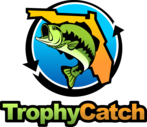 With TrophyCatch Season 5 wrapped up, the big events capping the season included the Phoenix Boats TrophyCatch bass boat drawing and the Hall of Fame ceremony (below)! As Season 6 got underway on October 1, the TrophyCatch program is proud to have approved an amazing 7,280 bass submissions over 8 pounds! This is an incredible amount of data that is being used for Florida bass conservation and research, and has already been presented at national fisheries symposiums. Thanks to all our participants and our partners for making the TrophyCatch program an incredible success!
|
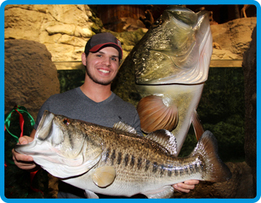 The Season 5 Hall of Fame Ceremony included an anniversary celebration as TrophyCatch completed its fifth year. The grand event took place at Bass Pro Shops Orlando. All previous HOF winners were invited, in addition to 16 HOF winners from this year! The TrophyCatch Champion was Dominic Montalto with a 16 pounds, 12 ounce giant caught in an Estero, Florida pond. This is also the largest bass submitted to the TrophyCatch program to date, and less than a pound shy of the state record. Each HOF winner received a customized and incredibly lifelike fiberglass replica mount from New Wave Taxidermy, gift cards from Bass Pro Shops and Enigma rods, and a commemorative photo plaque from American Registry.
|
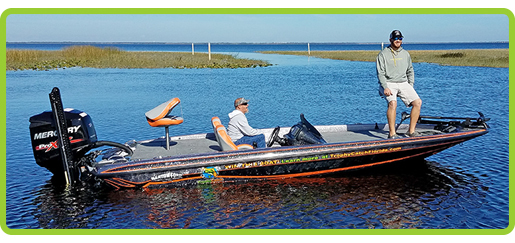 |
The annual Phoenix Boats package that is powered by Mercury and anchored by Power-Pole is given away through a random drawing and wrapped up a busy Season 5! The drawing between the five randomly selected finalists was held this year at Camp Mack's River Resort following the Bobby Lane Cup charitable fishing tournament. Mark Ortel (on right) was the winner of the Phoenix 819 Pro boat. Remember that just by registering for TrophyCatch (for FREE!) your name will be included once in next year's boat drawing!
 Size: This is Florida's largest freshwater game fish! The state record is 42.24 pounds, though fish are more typically caught in the 10 to 20 pound range. The Big Catch minimum qualifying sizes are 12 pounds or 30 inches for adults, and 9 pounds or 22 inches for youth (BigCatchFlorida.com).
Identification and similar species: Striped bass are fast, powerful fish with silvery sides and a white
belly. They have seven or eight black stripes along the sides. Stripes
are absent on young fish of less than six inches, though this fish can usually be separated from similar species (sunshine bass and white bass) by its much larger size.
Angling qualities: Striper fishing is best from fall through spring. Live shad are very
effective. Use heavy tackle with 3- to 4-ounce weights in high flow areas.
Baitfish-like lures, such as heavy jigs or sinking or floating minnow imitations, also work well. White, chrome or chartreuse colors will all produce fish.
Where to catch them: In Florida, striped bass are found primarily in the St.
Johns River and its tributaries, and a few panhandle rivers. Specific sites include the Apalachicola River and Lake Seminole, Lake Talquin and the Ochlockonee River, Lake Harris, and the Escambia River.
Striped
bass need long stretches of flowing water to reproduce successfully.
These conditions are rare in Florida. Stripers do not tolerate water temperatures over 75˚ F for
long. During Florida summers, striped bass become less active and must
find cool water to survive. Striped bass populations depend on annual
stockings from FWC and federal hatcheries.
Illustration by Duane Raver, Jr.
|
 Size: 1,500 acres.
Location: Near Immokalee, Florida in Collier County.
Description: Lake Trafford is the largest south Florida lake after Lake Okeechobee. Aquatic vegetation consists of cattail,
American lotus, eelgrass, and planted bulrush. Fish species present in the lake include
largemouth bass, black crappie, bluegill, redear sunfish, and large
brown bullheads. Access to Lake Trafford is mainly by boat. However,
there is a small county park located on the lake that provides some bank
access. A nice public fishing pier, damaged by Hurricane Irma, has now been renovated and restored. Lake Trafford Marina and
the park both have public boat ramps. Services available from the marina
include boat rentals, guide service, airboat tours, and bait and
tackle. Anglers wanting the most current lake conditions can contact the Lake Trafford Marina at 239-657-2401.
|
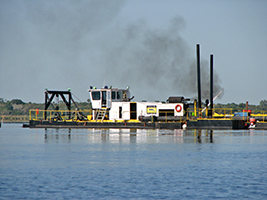 Lake Trafford experienced several large fish kills in the 1990s and 2000s, resulting in a major cooperative lake restoration and enhancement program by the Florida Fish and Wildlife Conservation Commission, Collier County, and the South Florida Water Management District - Big
Cypress Basin. Project activities included a major dredging and muck removal operation (see photo), bass stocking, and native vegetation plantings.
|
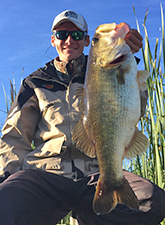 Lake Trafford has responded very well to these restoration efforts. One of the most telling signs of recovery have been increasingly larger bass caught in the lake, and documented by FWC's TrophyCatch bass catch-and-release program. The first TrophyCatch-eligible fish (8 pounds or larger) weighed 8 lbs. 2 oz. and was submitted in 2015, and the largest is a 10 lbs. 7 oz. bass just recently submitted in June 2017. Although the lake did not make BassMaster's Top 100 list in 2016, a very nice cap to this success story was their follow-up story "Lake 101: The little lake that could". Lake Trafford has been an outstanding example of restoration and cooperation.
|
Okeechobee, Rodman, Toho — big names mean big fish in Florida, the Fishing Capital of the World! But with three million acres of lakes and ponds, Florida also offers much smaller and more personal fishing experiences too. For these smaller waters — a backyard pond, roadside drainage canal, or HOA lake — here's a personal collection of favorite lures that will nearly always find fish.
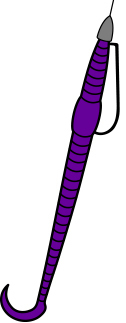
Bass — If I had to stick with just one lure for small-water bass, it
would be a 4" to 6" black plastic worm — though each angler will have their favorite color. As a kind of opposite to the "big lure, big
fish" theory, my thinking has always been that while a big fish can still
swallow a small lure, an overly-big lure will bypass a lot of small-water fish. And
while I prefer catching big fish over small fish, I’m much happier with
catching smaller fish than with catching no fish at all. I’ve hooked bass up to
4 pounds on 4" worms, and have enjoyed catching many smaller bass on light
tackle that I’m sure would never have touched an oversized worm. I like
curly-tail worms for a little action in the lure, and though I prefer all-black
I’ve also had good results with brightly colored firetail worms with red
curlytails. I usually rig the worm Texas-style, with a 1/0 or 2/0 worm hook and
a 1/16 or 1/8 ounce bullet sinker. As with most plastic worms, a wide range of
retrieves will work; in fact, it’s hard to work this one in a way that won’t
attract bass. Bass will readily swallow these smaller worms, so I set the hook
fairly quickly when I get a strike.
|
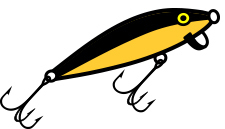 My second-favorite
lure for bigmouths has to be a 2" (#5) or 2¾" (#7) original floating Rapala minnow. The
old adage of using silver in clear water and gold in dark water has worked well
for me. For covering lots of water quickly, I’ll fan-cast the lure around my
position with a quick underwater retrieve, throwing in a twitch or two every
few handle cranks. My favorite method, however, is twitching the floater on the
surface near vegetation or over structure to draw surface strikes. I’ll let the
lure settle and allow all the surface ripples to fade away before twitching the
lure again. This technique requires a great deal more patience and won’t cover
much water quickly, but can be deadly, especially during spring.
|
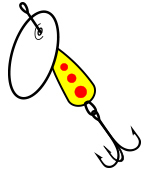 Sunfish — I usually use bait when targeting sunfish, but
occasionally I like to break out my ultralight lures and spend an enjoyable
morning going artificial-only. My top choice is a silver Panther Martin
spinner, in size 1 (1/32 ounce) or size 2 (1/16 ounce). I prefer the
lead-weight body over the steel chrome-plated version as it adds a bit more
weight for casting. A silver or copper #0 Mepps Aglia is my second spinner
choice (or the even tinier #00 if you can find them). Needless to say, you’ll
have to use light or ultralight gear to toss these. I’ll give the lure a sharp
twitch to start the blade spinning, and then continue with a steady retrieve
with occasional twitches thrown in. Sharpen your hooks as bream frequently
short-strike artificials and a sharp point is more likely to catch them.
|
 My next choice for sunfish is
a tiny beetle-spin with curlytail grub, with white being my favorite grub
color. While not the most natural-looking pick, white is visible for a long
distance and shows up well in turbid water. I’ll use a pretty steady retrieve,
and can target denser vegetation with the semi-weedless beetle spin than I can
with the spinner. Again, I prefer the smallest sizes (1/32 or 1/16 ounce), due
to the tiny mouths of the fish I’m targeting. Medium-sized bass will also hit
these tiny beetle spins, an especially challenging surprise if you’re only
using two or four pound test line.
So, that’s my short list for tiny-water bass and bream lures. I don’t always land the heaviest fish,
but I seldom get skunked!
|
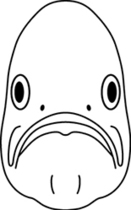
In the
last issue we learned some of the basic principles of seeing under water. This
issue will continue exploring the sight of fish, and provide some practical
suggestions for anglers. Underwater, where
visibility is usually limited to dozens of feet under even the clearest
conditions, there is little need for long-range vision.
Fish have been
described as being nearsighted, and can probably focus on objects much closer
to their eyes than humans can. Cast a popping bug near a school of bluegill and
one of them will often approach within an inch of the lure to inspect
it—something that would leave an angler cross-eyed! Even when a fish first
detects an object off to the side, it will usually turn and face it in order to
examine it. Why? The likeliest explanation is that this brings the object
within the narrow range of a fish’s binocular vision.
Unlike humans, many fish
have their eyes set far apart on the sides of the head rather than to the front.
This allows a very wide arc of monocular side vision for spotting predators or prey, but
provides only a narrow range of overlapping binocular vision to the front.
There is a blind spot to the rear, and the range of binocular vision to the
front encompasses only about 30-45 degrees. For this reason, some experienced
anglers believe a fish is more likely to spot a lure if it is cast to the
fish’s side instead of directly in front of it. Once a fish spots something,
turning to face it undoubtedly gives the fish a better estimate of the object’s
distance. Even though fish will turn to examine objects, their eyes do have
limited independent movement within the sockets. Like humans, a fish’s eyes move
in unison when looking around.
|
 |
A fish has a narrow range of binocular vision to the front, a wide range of monocular vision to both sides, and a narrow blind spot to the back.
And finally, the big question facing
anglers and lure manufacturers the world over: Do fish see color? Yes they do! In many cases fish color vision is probably comparable to that of humans.
So you can justify purchasing Uncle Joe’s Bass Slayers in
all thirty-two available colors! Like those of humans, fish retinas possess both
cones for color vision as well as rods for black and white vision. During
daylight, fish use primarily cones for vision. At night the rods, which provide
much higher light sensitivity and resolution, are used instead. The process of
switching between using cones instead of rods (and then back again) may take
two hours, and a predatory fish whose eyes adjust more quickly than those of
forage fishes will have a visual advantage during dawn and dusk—at least one
reason why these times usually provide the best fishing. Sharks, interestingly
enough, do not see color.
A very important factor in fish
color vision is water depth. Water completely absorbs (or attenuates)
different colors of light at different depths, affecting which colors are
visible to a fish. Water attenuates red light from the spectrum first, oranges
and yellows next, and blues and greens last (see the chart below). What this
means is that at a particular depth a red lure will no longer look red but
might appear as black or brown, while a green lure at the same depth could
still look green. At even greater depths, colors are no longer visible and fish
probably see objects in varying shades of gray. It is therefore not surprising
that within both fresh- and saltwater fishes, shallow-dwelling species have
better developed color vision than deepwater fishes. Of course, water turbidity
that inhibits light penetration greatly reduces the depth at which a particular
color is visible.
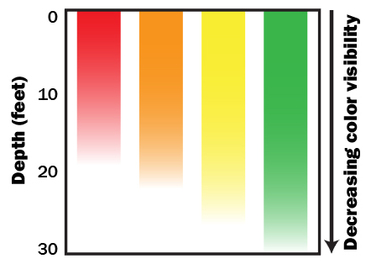 |
Colors disappear with depth. Red is no longer visible at 20 feet, but green is visible down to 30 feet or more.
Despite the fact that red is the
first color to disappear from the underwater spectrum, some research has shown
that red elicits the strongest response from largemouth bass. Yellow was the
next most important color for this species. Other research has suggested that
largemouth bass also possess some of the better color vision among common
sportfishes, followed by smallmouth bass, muskie, northern pike, rainbow trout,
bluegill, crappie, and gar. Fishes which feed primarily by smell, such as
catfishes, may have poor color vision in comparison.
We hope you "see" what fish see a little better now!
To contact the Florida Freshwater Angler, email John Cimbaro.
|